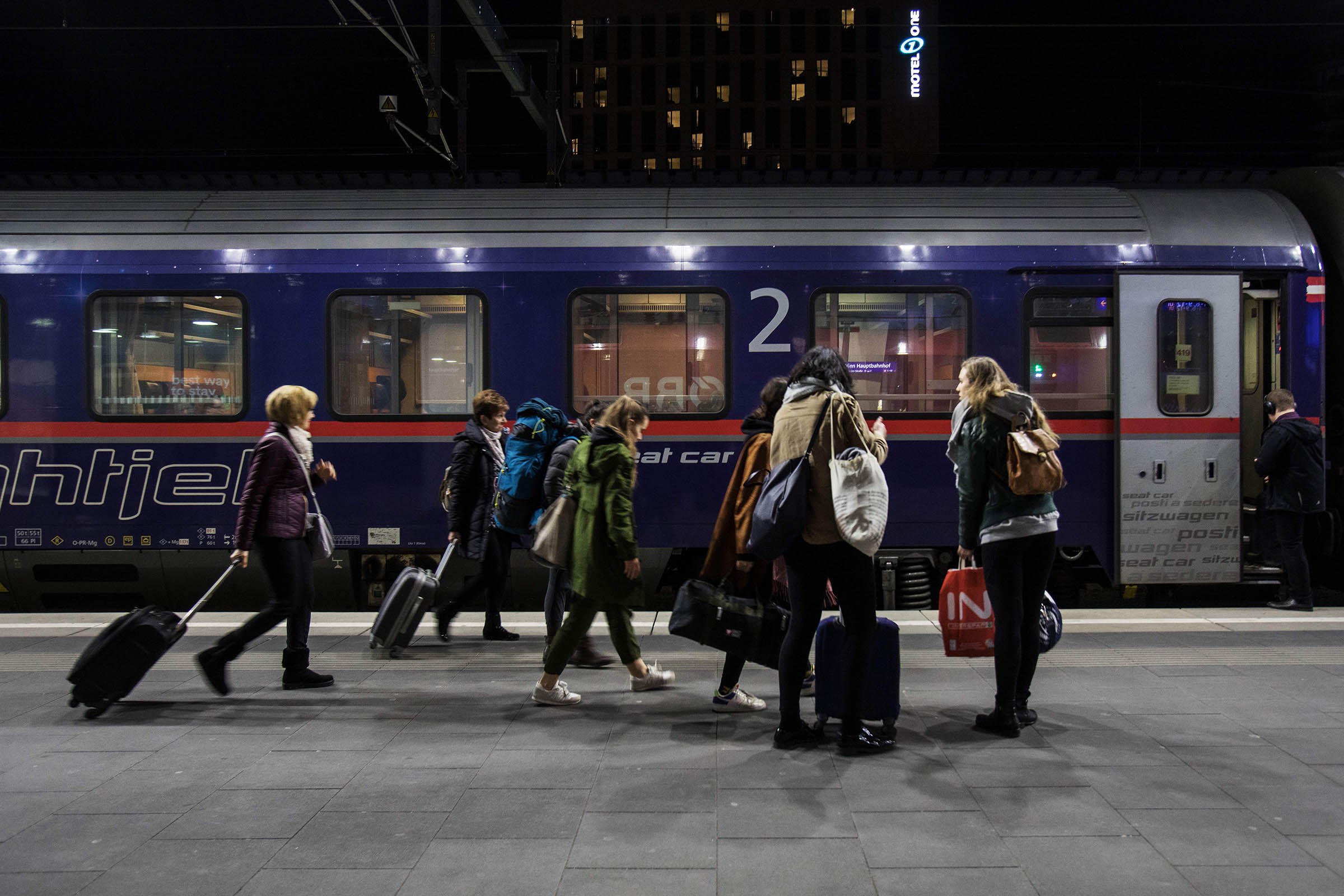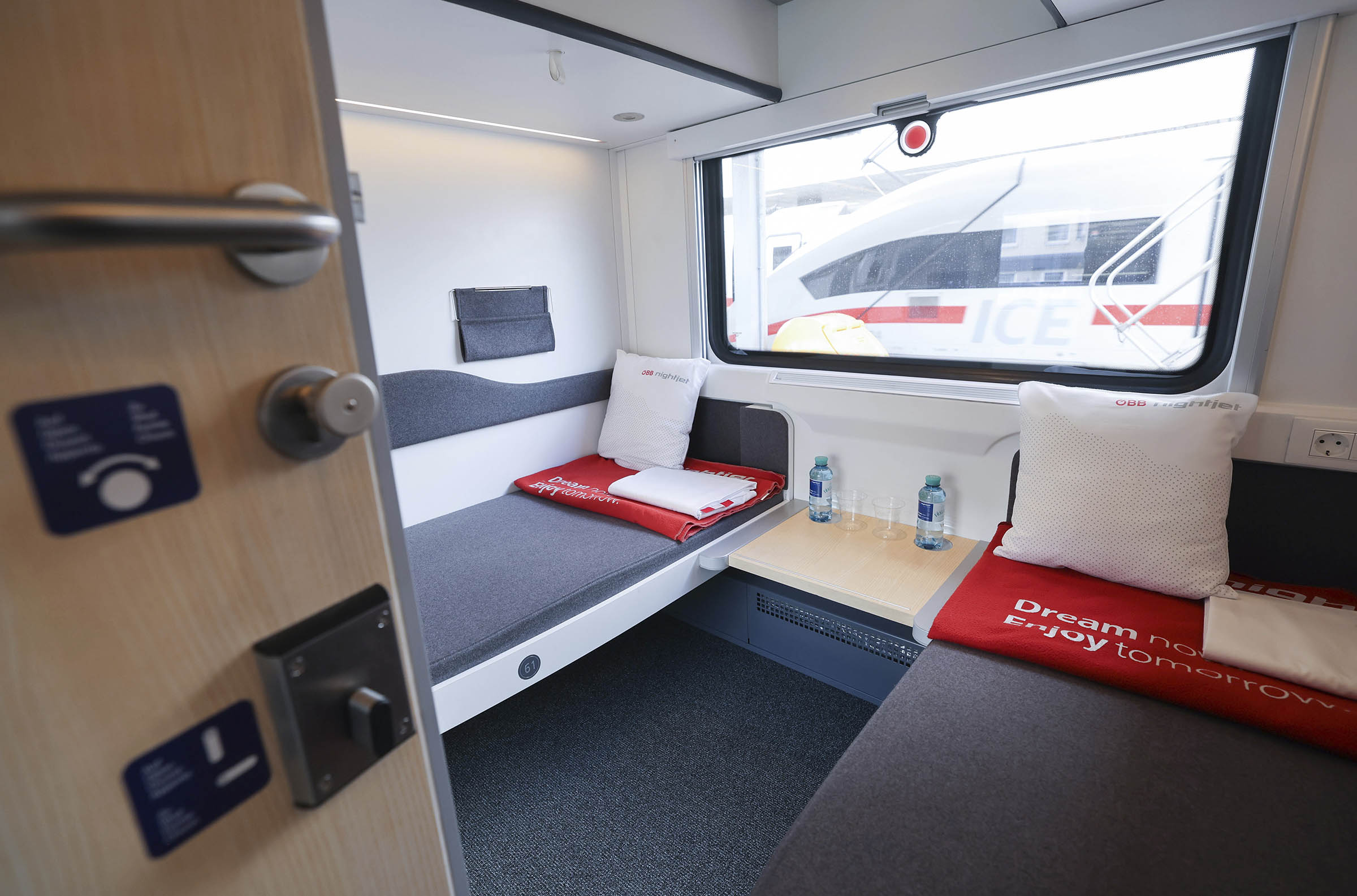
On a sweltering Sunday evening in late July, Klaydy Buchsbaum boarded a train bound for Vienna at Paris’s Gare de l’Est, slid open the door to compartment 412, tossed her hat onto the upper bunk for her overnight journey and got down to the serious work of maneuvering her oversized lavender suitcase into place. “Flights were so expensive, and with all the chaos in flying right now, I didn’t want to get stuck in an airport somewhere. And I didn’t want my bag to get lost,” she said. With a final push, she wedged the behemoth beneath her seat. “As my husband always says, I’m not the kind of person who travels with just a small carry-on.”
This summer’s air travel chaos has added another reason why a growing number of European travelers are opting for the rails. But a key factor—and the one behind a number of public and private initiatives to bring back overnight trains—is concern over climate change. Journeys by rail can emit as little as one fifth the greenhouse gasses as flights, which is why railway companies, national governments and E.U. bodies cite reducing emissions as a reason for re-establishing a network of overnight medium-distance rail lines that once connected the continent. Yet for all the demand and effort, those initiatives still have a long way to go.
Read More: Why Air Travel Is Hell This Summer
Europe’s night train network began eroding in the 1990s. As low-cost airlines like easyJet and Ryanair emerged, demand for overnight trains evaporated. By 2019, both Germany and Switzerland had sold off or shut down their night connections altogether, and the total number of passenger night trains in Europe had decreased from around 1,200 per week in 2001 to about 450. The dismantling made it difficult for even the most determined passenger to book a cross-continental ticket; today anyone hoping to travel by train from, say, Copenhagen to Barcelona, would have to cobble together their own ticket by navigating a bewildering thicket of national timetables and websites, and then change trains anywhere from three to eight times along the two-day journey.
One national company has begun in recent years to take steps to revive overnight trains. Citing growing concern about climate change, Austria’s state-owned railway ÖBB bought up some of the old international lines in 2016 and began launching overnight journeys at a rate of about one per year. The Paris-Vienna Nightjet began running in December 2021.
In 2019, those efforts got an important boost when flygskam—the Swedish word for “flight shame”—burst into public consciousness around the world, thanks to activist Greta Thunberg. And they swelled again this summer when widespread staff shortages resulted in a turbulent season of canceled flights and lost luggage. “Before corona, we were always full during summer months and during weekends and that was it,” says Bernhard Rieder, director of media relations for ÖBB. “This year, from Easter, we’ve been completely full on all lines every day. We get a lot of complaints from people who say ‘we hardly have a chance to get a seat or a bed’.”
Some start-ups have been paying attention. In 2019, growing criticism over carbon-spewing flights coupled with the lack of convenient cross-border rail options, prompted businessmen Adrien Aumont and Romain Payet to found Midnight Trains. It’s a private company that, when it is up and running, promises to connect 10 European cities from its hub in Paris with transport that is more like a hotel on rails than a traditional night train. “This is a product that hasn’t been reinvented for the last 20 to 30 years,” says Payet. “So we started working together on how to reinvent the night train to make it the most sustainable and comfortable way to travel across Europe.”

When Midnight Trains launches its first line in 2024, there will be easy online booking and refunds, a dining car serving recipes designed by a Michelin-starred chef and a range of accommodations—all of them private and outfitted with real beds and linens.
Read More: Going on Vacation This Summer? Welcome to the ‘Revenge Travel’ Economy
There are complications for both public and private night train initiatives. Prices are one: in late July, a one-way Paris-Vienna Nightjet ticket for a berth in a four- or six-person couchette cost around 154 euros (the exact costs vary by date and amenities), which was slightly more than plane tickets at that point. Part of the discrepancy is a disadvantage built into the European pricing structure: airline tickets are exempt from VAT but rail ones are not.
And of course, a rail journey is significantly longer. Passengers boarding the Nightjet avoid the schlep to an airport and snaking security lines. But the trip from Paris to Vienna still takes 14 hours versus 2.5 by plane. Some of that is down to rail traffic that forces trains to sit idle—sometimes for as long as 45 minutes—on the tracks. “People have this perception that the tracks are empty, but that’s not true,” says ÖBB’s Rieder. At night, the tracks are crowded with slow freight trains, which makes competition fierce to get a spot on the tracks.
There are also technical and juridical reasons for the frequent delays. The specifications of engine cars still vary from country to country and therefore often need to be changed at border crossings due to different power supplies and safety regulations. Once the trains stop, authorities frequently use the opportunity to board and inspect passenger passports—even within the border-free Schengen area that covers some 26 European countries. “We’re trying to buy locomotives that will be interoperable between countries so we don’t have to stop at the border, but the manufacturers are saying they won’t have those ready until 2026 or ‘27,” says Payet from Midnight Trains. Meanwhile, the company is also working on a system that would allow passengers to upload identity documents before traveling, just as airlines do.
Many of these issues are addressed in the European Commission’s Action Plan that was approved at the end of 2021. It calls for the introduction of a Europe-wide ticketing system that would allow passengers to easily piece together international trips, infrastructure investments that would remove the need for locomotive changes at the border and a reconsideration of VAT charges. But even the target adoption date of the end of this year for the digital booking system has already been pushed back into the second half of 2023.
“It’s not something that’s easy,” says Adalbert Jahnz, European Commission spokesperson for transport. “We’ve got 25 networks on the European level, which are pretty complex.” Jahnz says the E.U. has made headway by directing 50 billion euros of its COVID-19 recovery funds to rail and passing legislation that creates Europe-level certification for rail infrastructure.
Meanwhile, the E.U.’s goal of cutting carbon emissions by 55% by 2030, and reaching the more ambitious target of net zero by 2050, has been a boon for rail. During the pandemic, France and Austria made bailout money to their respective national airlines contingent on phasing out domestic flights under three hours, and since then, France has outright banned short haul flights if rail or bus alternatives exist. The energy crisis has also provided a boost: this summer, Germany reduced all domestic rail tickets to 9 euros for 3 months, while Spain made regional and commuter trains free between June and August.
Yet from the rail companies point of view, huge obstacles remain to meeting Europeans’ demand for rail travel, and the greatest is the lack of carriages—what the rail industry calls “rolling stock”—as the relatively few remaining manufacturers grapple with increased demand. “There are no new cars or even used cars available on the market,” says ÖBB’s Rieder. “In 2018, we ordered 33 complete new train sets. And they won’t be delivered until the middle of next year.”
The shortage of rolling stock helps explain why Midnight Trains won’t debut its first line, which Payet expects to be from Paris to northern Italy, until the second half of 2024. “When you look at the manufacturing sector, all of the big ones have backlogs for the next 10 years just from the national companies,” says Payet. “And if you’re a small, private company trying to get in [to the industry], they basically tell you, we’re full until 2028.”
The lack of new carriages also explains why certain amenities that could make overnight trains more appealing to travelers, like WiFi and plentiful electrical outlets, are missing on the Nightjet. Most of the cars are now 25 or 30 years old.
But Buchsmann, who enjoyed the simple breakfast that attendants bring to each passenger and liked having the chance to socialize over wine with the other women in her all-female compartment aboard, says she would eagerly take the Paris-Vienna Nightjet again. Still, she admits, she didn’t sleep all that well. “The beds were a little hard,” she says.
A couple of compartments away on the Nightjet, Jean-Baptiste Fouvry also had a relatively sleepless journey. On his way to a professional conference in Vienna, the 32-year-old had opted for a seat instead of a berth, and spent the night upright with five others in a crowded compartment. As an environmentally-conscious scientist at Paris’ Institute of Astrophysics, he still didn’t regret his decision to travel by train. “If you care about climate change,” he says in reference to the journey, “it’s not sufficiently horrible enough not to do.”
More Must-Reads from TIME
- Donald Trump Is TIME's 2024 Person of the Year
- Why We Chose Trump as Person of the Year
- Is Intermittent Fasting Good or Bad for You?
- The 100 Must-Read Books of 2024
- The 20 Best Christmas TV Episodes
- Column: If Optimism Feels Ridiculous Now, Try Hope
- The Future of Climate Action Is Trade Policy
- Merle Bombardieri Is Helping People Make the Baby Decision
Contact us at letters@time.com